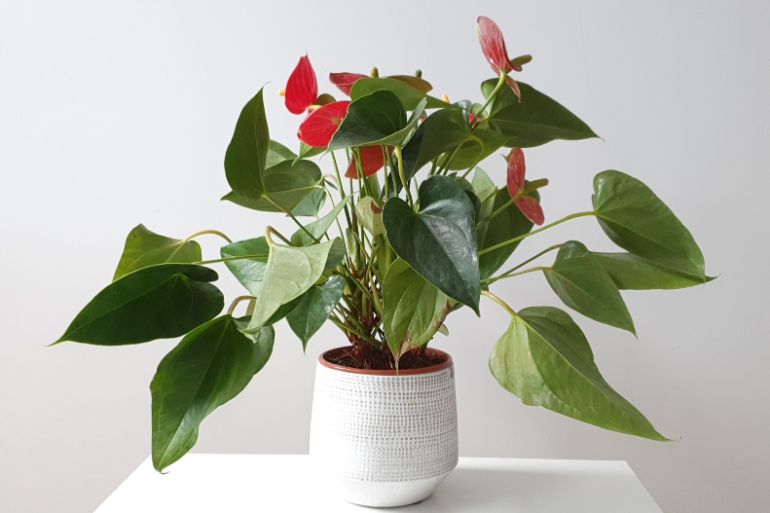Anthuriums are amongst the most popular houseplants, famed for their beautiful foliage, and in many cases, also for their stunning year-round blooms. If you’ve noticed your Anthurium getting brown leaves, it can be a cause for concern. Thankfully, this article is going to help you identify the problem, and help you get your plant back to perfect health.
The most common cause of an Anthurium getting brown leaves is excess direct sunlight, causing leaf scorching. Under and over-watering, low humidity, and acclimation are also very common causes. Identifying the cause is a crucial step in fixing the problem.
Whilst these are the most common causes, there is a list of potential problems that can cause brown leaves on your Anthurium. The good news is that you can identify the problem with your plant by checking the growing conditions and looking at the type and pattern of leaf browning and other symptoms.
Causes Of Brown Leaves On Anthurium Houseplants
Let’s look at each of the potential causes of brown leaves on Anthuriums, to help you work out what the problem is with your plant. By looking at each issue in turn, hopefully, you will work out which issue or combination of issues is causing your plant to be so unhappy.
Whether you have the ever-popular Anthurium andreanum, or one of the gorgeous, but less common varieties, by the end of this article, you will know exactly what is wrong with your plant., and know what steps to take to fix it.
Excess Direct Sunlight
This is probably the most common cause of brown leaves on Anthuriums. Strong direct sunlight will cause heat damage to the leaves of your plant, causing brown patches on the leaves.
Upper leaves and the most sun-exposed leaves will be the first to be affected. The pattern of leaf browning and the position of your plant in your home should make this a fairly simple problem to identify.
Many people assume that Anthuriums love plenty of sunshine, but they actually thrive much better in bright, indirect light.
Professionally cultivated Anthuriums are grown in light levels of 18000 to 25 000 lux. Whilst this provides very bright light, it is less than 1/4 of the intensity of direct sunlight.
How To Fix Lighting Problems Causing Brown Leaves On Anthuriums
The solution of course is simply to move your plant back from the window to a location that is bright, but doesn’t receive much if any direct sunlight during the day. You can read my article about light levels for indoor plants to learn more.
If you’re not sure how bright your home is, you can download a light meter app for any smartphone. There are many free apps on the Apple store or Android Play store that use your phone’s camera to take a reading of the light levels in your home.
I have found this so useful to find just the right spot for some of my plants and to monitor how much light intensity changes depending on the season and weather conditions outside.
After moving your plant to a more suitable location, resist the temptation to prune off the damaged foliage. Let your plant acclimate to the new conditions, and wait until it is producing some new, healthy growth before pruning off those unsightly brown leaves.
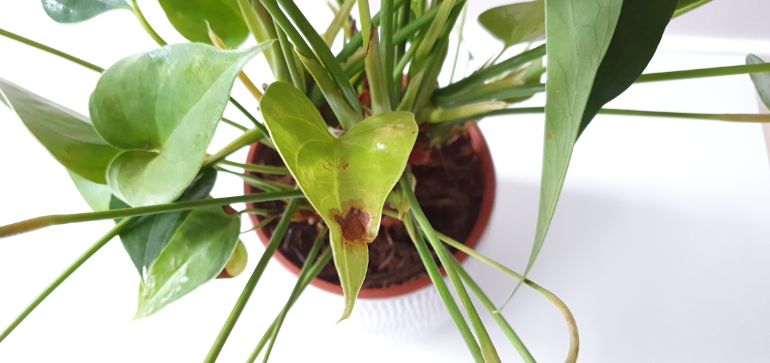
Overwatering
Overwatering is the most common problem you will run into when looking after your houseplants, and easily one of the most common causes of brown leaves on Anthurium houseplants.
The key to identifying this problem is to look at the pattern of leaf damage and check the conditions your plant is growing in. Look for generally yellowing lower leaves and brown leaf tips.
Overwatering is not just caused by watering too often. It is usually caused by a combination of factors that result in the plant growing in soggy, poorly aerated soil for a prolonged period of time.
Factors that can contribute include;
- Growing your plant in a pot that is too large for the plant.
- Planting in soil that drains poorly.
- Using a pot that few or no drainage holes.
- Placing your plant in low light conditions, resulting in reduced water use and soil that stays wet for a long time after watering.
How To Fix Brown Leaves On Anthuriums Caused By Overwatering
Anthuriums develop brown leaf tips when the roots are not functioning adequately to deliver water and nutrients to the tips of the leaves. If you see brown leaf tips on your Anthurium, along with yellowing of lower leaves and other evidence of overwatering, it is likely that root rot has set in.
You should take the following steps to save your plant;
- Gently remove your plant from it’s pot and inspect the roots for any signs of rot.
- Use sterile pruners or scissors to remove any rotten roots. These will be brown/black, mushy, smelly, and fragile. All rotten roots must be removed.
- Gently loosen the soil from around the healthy roots and then wash off any soil residue, leaving the roots fully exposed.
- Repot your Anthurium in a clean pot and use fresh potting mix. Use a loose, well-draining potting mix. A perfect option is to use equal quantities of peat or coco coir, perlite, and pine bark.
- If you have had to prune more than 1/3 of the roots from your Anthurium, it is best to prune up to 1/3 of the foliage as well. This will make it easier for the remaining roots to support the plant.
- Place your repotted Anthurium in bright, indirect light and provide high humidity.
- Monitor the soil moisture and water thoroughly once the top inch or two of soil feels dry to the touch.
- It will take your Anthurium several months to recover from this ordeal, but you will hopefully see new, healthy growth before too long.
- You can learn more about identifying, treating, and preventing root rot in this article.
Acclimation
It can be very disheartening to bring a new plant home, only to find your Anthurium getting brown leaves after just a few weeks. The good news is that this is often simply acclimation, and is one of the less serious causes of brown leaves on Anthuriums.
Anthuriums are normally grown in perfectly controlled, ideal conditions by the grower, and it is difficult to match these conditions in your home. Due to this, your plant will take a while to adjust to the changes in lighting, temperature, humidity etc in your home.
You may see a few of the lower leaves turn brown and eventually fall off, or some of the leaves may develop brown spots, often around the edge of the leaves.
How To Prevent Anthuriums Getting Brown Leaves Due To Acclimation
There are a few things you can do to ensure your Anthurium suffers minimal issues after you bring it home.
- Buy from a reputable seller who has kept the plants in suitable conditions while they were on sale.
- If buying from a large store, try to buy your Anthurium soon after it has been delivered to the store. This will minimize the time it has spent in suboptimal conditions.
- If purchasing online, try to avoid ordering when temperatures are below 50°F (10°C), as this can lead to your plant experiencing cold stress during delivery.
- When you get your plant home, make sure to provide lighting, temperatures, and humidity levels that are as close to those that the plant is naturally comfortable in. You can read my guide to caring for Anthuriums to get all the info you need.
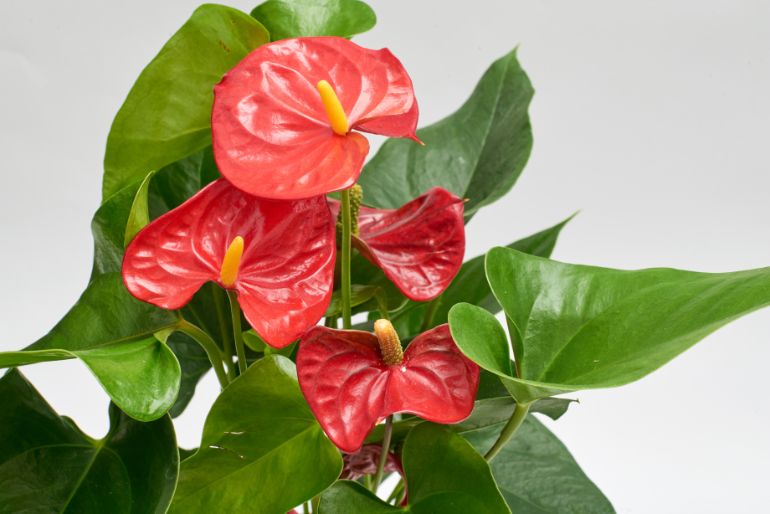
Overfertilizing
Overfertlizing is another reasonably common cause of brown leaves on Anthurium houseplants. It almost always starts with the good intentioned gardener trying to provide everything their plant needs to help it grow big and beautiful.
Unfortunately, excess fertilizer salts are toxic to both the foliage and the roots of your plant, so caution is required.
The first signs of overfertilizing tend to be brown leaf spotting and brown leaf tips. Your plant may also languish and fail to grow as expected, due to the stress and damage being caused to the roots.
If you have been fertilizing on a regular basis and you start seeing your Anthurium getting brown leaves, stop immediately to prevent further damage.
Another sign of overfertilizing is seeing white/brown crusts on top of the soil, as fertilizer salts accumulate.
How To Fix Brown Leaves On Anthurium Houseplants Caused By Overfertilizing
If you think the brown leaves on your Anthurium are due to overfertilizing, there are a number of things you should do to try to fix your plant.
- Flush the soil with copious quantities of water. This will help dissolve excess fertilizer salts and flush them out of the soil.
- Stop fertilizing for at least 6 months until your plant is producing new, healthy foliage again.
- If you have used granulated fertilizer, or the build-up in the soil is severe, you could consider repotting it into fresh soil. Whilst this does cause additional stress for the plant, it may be the only way to save a severely overfertilized plant.
Anthuriums only need a small amount of fertilizer to keep them healthy. I tend to use a synthetic, balanced fertilizer applied at half the recommended concentration every other month during the growing season.
However, using an organic fertilizer tends to reduce the risk of overfertilizing. You could also consider adding 10% compost or worm castings to the potting mix, which will largely replace the need to add supplemental fertilizer for at least two years.
If you’d like to prevent any fertilizer problems in your houseplants, read my guide to fertilizing houseplants.
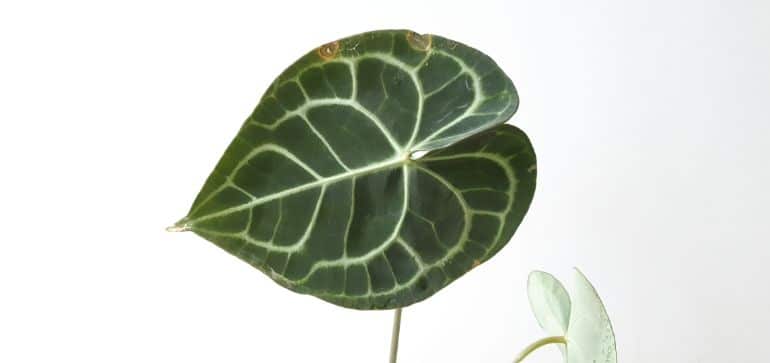
Pests
Damage from pests can result in your Anthurium getting brown leaves, usually caused by the direct damage caused by pests feeding on the foliage. Look for irregular brown or yellow spots on the leaves, or even holes in the leaves.
Thrips and aphids are the main pests you will see on anthuriums. Determining whether the brown leaves on your Anthuriums are being caused by pests is as simple as looking closely for the pests themselves.
How To Treat And Prevent Pests Causing Brown Leaves On Your Anthurium
The most important thing with houseplant pests is to detect them early. It’s generally good practice to inspect your plants every time you water them for any evidence of pests.
You’ll need to check both sides of the leaves, as well as along the stems and even in the soil. Pests like thrips, aphids and mealybugs can be spotted easily if you are observant, but spider mites can be really difficult to spot until an infestation has become a major problem.
- Isolate the affected plant as soon as you detect a pest infestation, to prevent it from spreading to other plants.
- Manually remove as many of the pests as possible, or use a hose, tap, or showerhead to wash the bugs off the foliage.
- Treat your plant at weekly intervals with isopropyl alcohol, neem oil, or horticultural oil spray to eliminate most pests.
Prevent pests by isolating any new plants for two weeks when you bring them home. If there are no signs of pests after two weeks, then you can introduce your new plant to the rest of your houseplant collection. Learn more about treating and preventing houseplant pests in this article.
Disease
Fungi such as Fusarium, Pythium, Phytophthora, and Calonectria, and bacterial diseases caused by Xanthomonas and Pseudomonas can result in your anthurium getting brown leaves.
Many of these diseases cause irregular brown spots or patches on the leaves of Anthurium plants. Rapidly spreading, irregular brown patches in the absence of visible pests should be assumed to be due to disease.
How To Treat Diseases Causing Brown Leaves On Anthuriums
Rapid treatment is crucial, as an advanced disease will result in the death of your plant. The best course of action is to prune off all affected foliage as soon as possible with sterile pruning shears.
Topical treatments are usually ineffective and are not recommended as an alternative treatment option. If the majority of the leaves of your Anthurium have brown patches or spots caused by infection, the best course of action is to dispose of the plant.
Prevention revolves around providing care conditions that help the plant to grow strongly and maintain natural disease resistance. In particular, avoiding overwatering, low light, and excessively high humidity without sufficient ventilation are the best ways to prevent diseases.
Low Humidity
Low humidity will result in a number of changes to the leaves of your Anthurium. Many varieties will lose the shiny appearance of their leaves, and your Anthurium will get brown leaves in low humidity conditions in the form of brown tips and leaf edges.
Low humidity will be a particular problem in centrally heated homes in winter, or if temperatures are high. I ran into this issue last winter when I boosted the temperature in my home over the winter months to keep my houseplants happy. Unfortunately, this resulted in plummeting humidity levels and browning on the leaves of a number of my anthuriums.
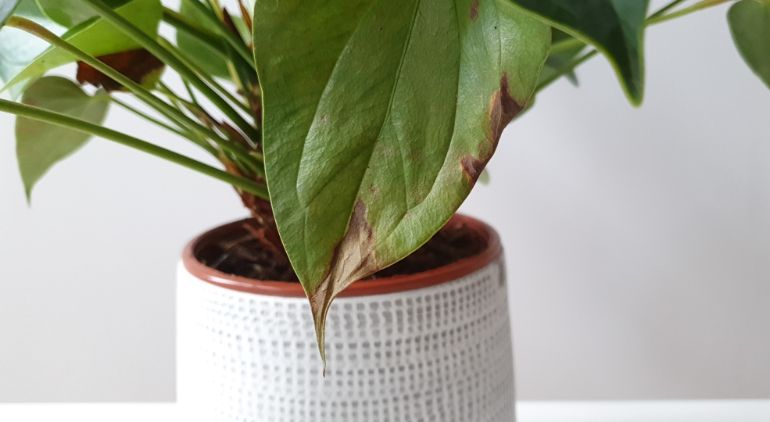
How To Prevent Brown Leaves On Anthuriums Caused By Low Humidity
I would hugely recommend monitoring the humidity levels in your home to prevent brown leaves on your Anthurium. I use a digital hygrometer/thermometer in my home to monitor humidity and temperatures. It is the single most useful piece of equipment I have for keeping my houseplants healthy.
Try to maintain humidity levels of at least 40% all year round. Some varieties of Anthurium require humidity of at least 60%, and this is the target I aim for in my home to keep most of my houseplants happy.
There are many ways to increase humidity in your home. Here are some great options;
- Group your plants together – the increased transpiration creates a humid microclimate around your plants.
- Place a shallow dish of water beside or beneath your plants. This increases humidity due to increased evaporation.
- Move your plants to a bathroom or kitchen, where natural humidity levels will be higher than in other rooms.
- Avoid misting your houseplants. I don’t find this to have much if any impact on humidity levels.
- Use an electric humidifier. Whilst other measures help, using a humidifier is the best option. Pick one with a large water reservoir so you don’t need to refill it too often.
Underwatering
This is one of the more obvious causes of an Anthurium getting brown leaves, but it is very common. Damage is more likely to affect old leaves, which can turn completely brown and fall off. It will also affect the youngest leaves, which can get brown tips and edges.
Anthuriums can also wilt quite dramatically if they are underwatered. Anthurium andreanum, the most common variety by far, has a tendency to turn the upper surface of its leaves towards the ground and curl them a little when underwatered. These are both water-saving techniques.
Identification is easy, as the soil will feel dry and the pot will be light, due to the lack of water content.
How To Prevent Underwatering From Causing Brown Leaves On Your Anthurium
It can be difficult to remember to water your houseplants, so getting into a routine of checking your plants a few times a week is a good habit that will prevent a lot of problems.
Water your Anthurium once the top 1-2 inches of soil feels dry. Soak the soil thoroughly, and then let the pot drain the excess water for a few minutes, before putting your plant back in its normal spot. Read my guide to watering houseplants for some helpful tips on getting this crucial aspect of houseplant care right.
Although this seems like a simple problem with a simple solution, there are a few things that can make underwatering much more likely;
- Could your Anthurium be rootbound? A rootbound plant will dry out much more quickly after watering. consider repotting into a larger pot.
- Is the soil draining too well? Good soil balances some water retention with being well-draining. However, if you plant in a mix that doesn’t retain some of the water, it will dry out very quickly and your plant will wilt, dry out and develop brown leaves much more easily.
- Could your Anthurium be getting too much light and heat? Both of these will cause water use to increase a lot, drying the soil out quickly. Consider reducing the temperature of the room your Anthurium is growing in and move it to a less intensely lit location.
Cold Stress
Anthuriums are tropical plants that do best in temperatures of 59-86°F (15-30°C). Outside of this range, particularly below the lower end, they will suffer foliage damage due to cold stress, resulting in brown leaves on your Anthurium. Often this first presents as indistinct patchy yellowing, that soon turns brown and spreads to the rest of the affected leaf.
Leaf browning due to cold stress usually worsens over the course of several weeks after the plant has been exposed to intolerably low temperatures. Even a few hours of cold can cause some cold damage.
The most common causes are due to a plant being left in a drafty or cold room in winter, or occasionally when a plant is left within range of a cold air conditioning vent. Bear in mind that your plant could also be exposed to cold during delivery, or on the way home from the store.
The solution here is to monitor the temperature your Anthurium is exposed to. My digital thermometer comes in really handy here too, as it records the maximum and minimum temperature over time, allowing me to see at a glance if my plant is being exposed to low temperatures at any point.
It can take several months for an Anthurium to recover following cold stress. avoid pruning damaged foliage until you see new, healthy leaves growing.
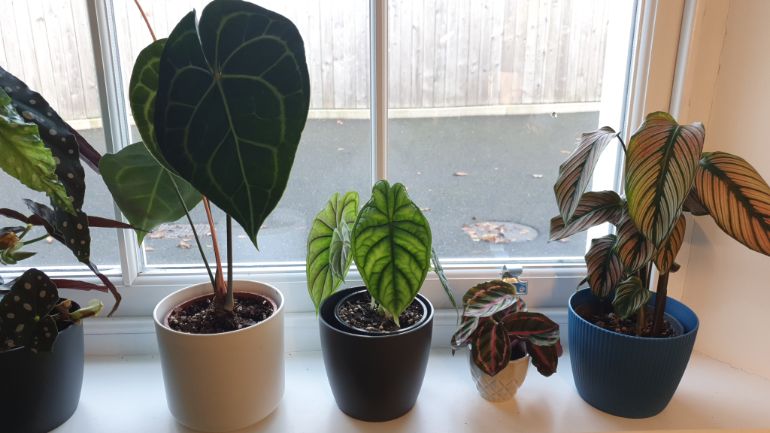
Old Foliage
You may see a lower Anthurium leaf turn brown from time to time. This is entirely normal, and part of the process where the plant redirects resources to new growth. As long as your plant is only losing 1-2 leaves at a time in this way, you can be confident that there is not a major underlying problem.
Make sure to double check the care you are giving your plant and adjust as necessary in case this could be an easly sign of a problem.
Last Word
I really hope this article has helped you work out why your Anthurium has brown leaves and has given you some tips to get your plant back to perfect health.
If you’ve run into a few problems with your Anthurium, just remember that dealing with problems is one of the best ways to learn more about growing healthy houseplants.
If you’d like to learn more, I’ve written plenty of articles on many different aspects of Anthurium care and indoor gardening.
- How To care For Anthurium Houseplants.
- 42 Stunning Anthurium Varieties – Pictures, Descriptions, And Care Tips.
- Why Is My Anthurium Not Flowering?
- How To Prevent And Fix Yellow Leaves On Anthuriums.
- Complete Guide To Anthurium Clarinervium Care.
- 19 Stunning Flowering Houseplants You Will Love.
- Check Out My Book, “Houseplants Made Easy”.

